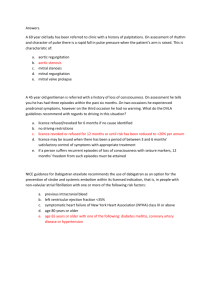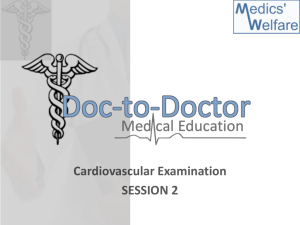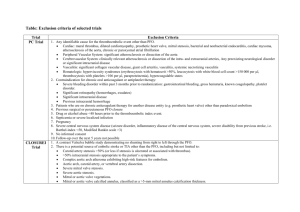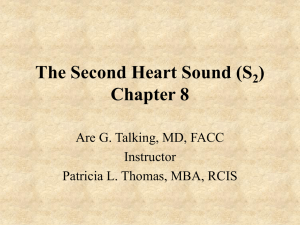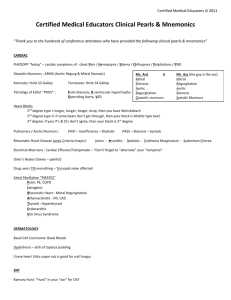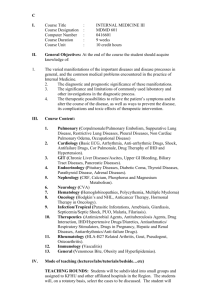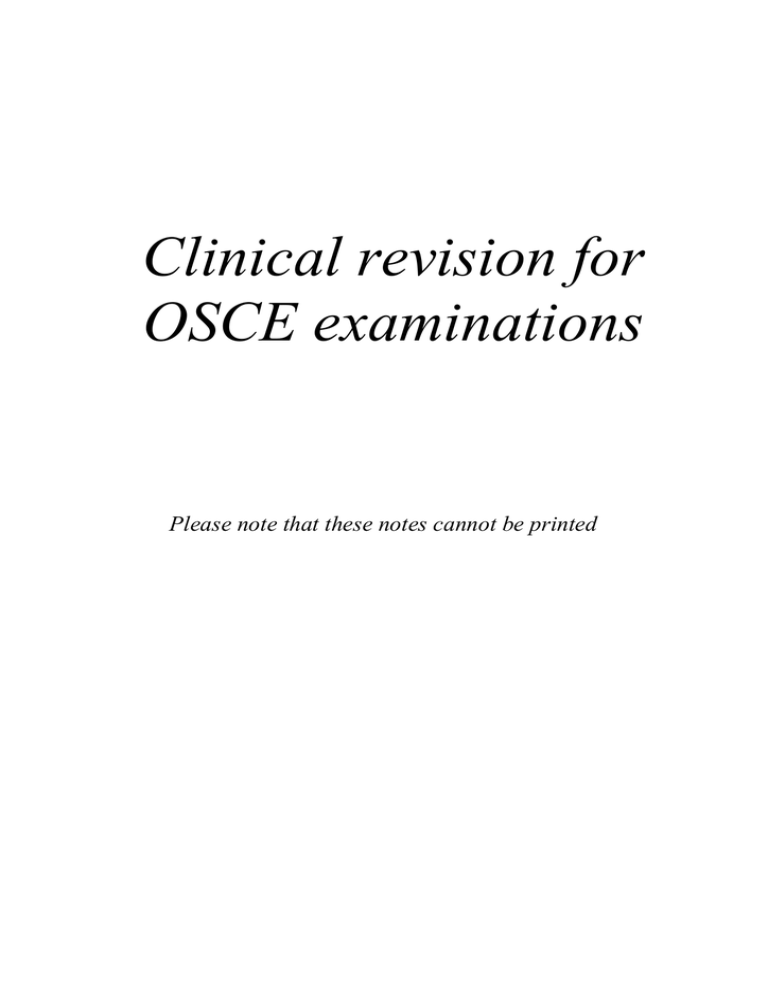
Clinical revision for
OSCE examinations
Please note that these notes cannot be printed
© Copyright 1994-2009 Academic Medical Publishing.
Tudor Lodge, Roseworth Crescent, Newcastle upon Tyne NE3 1NR.
First published 1994
Reprinted Annually 1995-2006
14th reprint - 2007
All rights reserved. No part of this publication may be reproduced, stored in a retrieval system, or transmitted in
any form or by any means, electronic, mechanical, photocopying, recording or otherwise without the prior
written permission of the copyright owner. Any breach of this copyright will lead to prosecution.
Whilst the advice and information in this book are believed to be true and accurate at the date of going to press,
neither the author nor publisher can accept any legal responsibility or liability for any errors or omissions that
may be made. Every effort has been made to check the drug dosages given in this book. However, as it is
possible that some errors have been missed or that dosage schedules may have been revised and the reader is
strongly urged to consult the drug manufacturers literature or the British National Formulary before
administering any of the drugs listed in this book.
British Library Cataloguing in Publication Data
Dark, G. G.
How to pass finals, course notes.
1. Medicine.
I. Title.
610
Typeset and produced by Academic Medical Publishing.
Text set in Times New Roman; titles and captions in Arial.
Printed in UK.
Chapter 5
Clinical revision for OSCE examinations
THIS ENTIRE SECTION IS DESIGNED FOR REFERENCE PURPOSES ONLY.
In the preparation period before finals you should be able to perform a basic physical examination of each of the
systems relevant to the exam and have an understanding of the physical signs that can be found during the
examination and their significance. There is no substitute for clinical experience and you are best advised to
examine as many patients as possible before the examinations start.
In this section there is a series of diagrams that outline suggested methods for the physical examination of
patients, not only for exams but also for the real clinical situations of outpatient and casualty departments. The
objective of the clinical diagrams is to optimise your physical examination routines such that signs relevant to
the problem can be specifically sought in an organised manner, which appears impressive to the examiners. The
concept of the diagram is to start at the bottom left hand corner and work up and around in a clockwise fashion.
It is hoped that you find these of benefit and that as your examination routines become more polished, you begin
to enjoy the challenge of achieving an accurate diagnosis. It is all a game and when you are more proficient, the
game becomes easier and more enjoyable ! Medicine can be fascinating but only for those who are on the look
out for interesting signs. If you don't look, you won't see !
How to use this clinical revision section
The best way of gaining benefit from this clinical revision section is to use it for reference after seeing a patient
with a particular condition. After completing your physical examination of a system you are then encouraged to
read the relevant page with the suggested method of examination for the same system that you have reviewed.
This will attenuate and reinforce your learning and encourage recollection of the situation when faced with the
same clinical problem in the future and may demonstrate specific points that were overlooked during your
routine.
Example presentations of clinical findings are given for each system and you should practise using these as
guidelines for other conditions that you encounter when examining patients on the wards during your
preparation. A list of the more common conditions encountered in the short cases is included and you should
become familiar with each of the conditions on these lists.
Specific advice for clinical examination is given with guidance to examination in the exam setting. Lists of
causes of physical signs found on clinical examination should be consulted after seeing a patient with that
specific condition. The arbitrary reading of such lists could be dangerous for your mental health if you do not
have the mental image of a patient with which to associate it.
Finally, a series of learning objectives are listed at the end of each system section and can be used as a basis for
your revision and preparation for the clinical examinations. Further space has been provided for you to add your
own revision notes.
Clinical revision for the short cases
63
Examination of the cardiovascular system
Common introductory directives
Please examine this patients cardiovascular system.
Please examine this patients heart.
Please examine this patients praecordium.
Examine the cardiovascular system.
Don't worry about the peripheral pulses, concentrate on the heart.
This patient is short of breath, please examine the cardiovascular system.
Listen to this patient's heart.
Listen to the apex beat.
This is Mr Smith, please examine the heart only.
Assess the cardiovascular system.
This patient has a problem with heart valves, please examine.
Examine the cardiovascular system and talk me through it.
Examine the JVP, apex beat and listen to the apex.
This patient has recently had a myocardial infarct.
Please examine the cardiovascular system.
This patient presented with a transient ischaemic attack. Examine the patient to elicit a cause.
Feel the pulse and listen to the heart only.
Look at this patient (recent sternotomy scar) and examine whatever you think is relevant (CVS).
Suitable cases for cardiovascular examination
MORE COMMON
Atrial fibrillation
Mitral incompetence
Prosthetic valves
Mixed mitral valve disease
Mixed aortic valve disease
Mitral and aortic valve disease
Tricuspid incompetence
Left ventricular failure
Infective endocarditis
Examination of the pulse
Irregular pulse
Atrial fibrillation
Slow pulse
Aortic stenosis
Complete heart block
Collapsing pulse
Brachial artery aneurysm
Tachycardia
Hypothyroidism
Vascular access graft (for dialysis)
LESS COMMON
Raised JVP
Mitral stenosis
Eisenmenger's syndrome
Atrial septal defect
Ventricular septal defect
Dextrocardia
Complete heart block
Pulmonary hypertension
Coarctation of the aorta
How to pass finals
64
You are asked to examine the cardiovascular system
conjunctival pallor
Argyll Robertson pupils (AR)
lens dislocation (Marfans)
xanthelasma
arcus senilis
high arched palate
dental caries
central cyanosis
JVP: waveform, height
cannon waves (CHB)
carotid pulse: quality, volune
Corrigan’s sign (AR)
De Mussett’s sign (AR)
blood pressure:
lying and standing
paradox (tamponade)
pulse: rate, rhythm and nature
? equal L & R
peripheral cyanosis
clubbing
nicotine stains
splinter haemorrhages
capillary pulsation (AR)
pallor
Janeway lesions/Osler nodes
arachnodactyly
xanthomas
rheumatoid changes
systemic sclerosis
palmar erythema
Inspection:
breathlessness/respiratory rate
sternotomy scars
mitral facies
poycythaemia
ascites
abdominal pulsation
marfanoid appearance
myxoedema
Down’s syndrome (ASD)
cushingoid appearance
anxiety
Introduce yourself to the patient
Optimally exposure the area to be examined
Position the patient correctly
Inspection:
pectus excavatum/chest wall symmetry
left parasternal impulse
look carefully for valvotomy/sternotomy scars
ankylosing spondylitis (AR)
Palpation:
site and quality of apex beat
tapping (MS)
thrusting (LVH)
dextrocardia
parasternal heave (RVH)
abnormal thrills/heaves
double impulse (HOCM)
Listen with diaphragm to:
apex
axilla
left sternal edge
Listen with bell to:
left sternal edge
then turn the patient to the left
and listen at apex in held expiration
Sit patient forward:
feel for parastenal thrill
listen in inspiration and expiration
listen to the neck:
murmur radiation
carotid bruit’s
feel for sacral oedema
and listen to the lung bases
Lie the patient flat:
feel for hepatomegaly (RVF)
pulsatile hepatomegaly (TR)
splenomegaly
aortic aneurysm
ascites
renal and femoral bruits
scar from vein removal (CABG)
calf tenderness, venous thrombosis
ankle oedema
peripheral pulses
capillary filling
clubbing (if present in hands)
When finished, thank the patient
Redress the patient
To complete the examination ask to examine:
temperature
radio-femoral delay
fundoscopy: hypertension
Roth spots (endocarditis)
urinalysis
Clinical revision for the short cases
65
Presentation of examination findings
There are two methods of presentation as covered previously at the beginning of this chapter; either a full
presentation of the complete examination in order or alternatively, presenting the diagnosis first, followed by
your reasoning for such a deduction. It depends on your level of confidence but if you have any doubt
whatsoever you are suggested to use the complete presentation format. This demonstrates your skills of
presentation to the examiners and if you do make an error when suggesting the diagnosis, they are quite likely to
score you favourably if you demonstrated the correct physical signs.
Complete examination presentation
On examination of the cardiovascular system, there were no peripheral stigmata of disease, except for pallor.
The pulse was 80 and irregularly irregular in atrial fibrillation with good volume. The jugular venous pressure
was raised 4 cm.
On inspection of the chest, there was a midline sternotomy scar and palpation indicated a thrusting apex beat
which was displaced to the sixth intercostal space in the mid axilliary line. There was a parasternal heave but no
added thrills.
On auscultation there was a soft first heart sound, a loud second heart sound, especially the pulmonary
component and a moderate third heart sound. There was also a 4/6 pansystolic murmur heard best at the apex
and radiating to the axilla, with no diastolic component. On auscultation of the lungs there are coarse crackles
heard in both bases posteriorly. Examination of the legs reveals peripheral oedema of both ankles and a scar
overlying the saphenous vein on the left. To complete my examination I would like to measure the blood
pressure, examine the abdomen for enlargement of the liver and test the urine.
In summary this patient has signs consistent with a diagnosis of mitral incompetence which is severe in nature
due to the presence of pulmonary hypertension and biventricular failure. There were no stigmata suggestive of
infective endocarditis and the surgical scars suggest that the patient has had surgery for ischaemic heart disease
with a vein graft to the coronary arteries.
Summary presentation
This patient has a diagnosis of severe mitral incompetence, as evidenced by; atrial fibrillation, a displaced
thrusting apex beat, a soft first heart sound, loud second heart sound, a moderate third heart sound and a 4/6
pansystolic murmur heard best at the apex and radiating to the axilla.
There is also evidence of concurrent pulmonary hypertension and biventricular failure but there were no
stigmata of infective endocarditis. The visible scars suggest previous coronary artery bypass surgery.
Both of these examples are for a patient with mitral incompetence, which is the most commonly encountered
case when asked to examine the cardiovascular system in the short cases. Think about how you would present
the findings for other cases that commonly occur in the examination.
Remember
You score marks for;
Approach to the patient and professional manner
Was the examination technically systematic and smooth?
Was the presentation systematic and thorough?
Accuracy of findings
Interpretation of findings
How to pass finals
66
Notes on examination of the cardiovascular system
In the exam setting
ATRIAL
The most common cardiac abnormality to be encountered in the short cases is mitral incompetence,
FIBRILLATION which is associated with atrial fibrillation. If you find a patient with atrial fibrillation be aware that
there may, be a mitral valve lesion. In finals you are quite unlikely to see a patient with pure mitral
stenosis as the physical signs may be quite difficult to find.
CYANOSIS
On general inspection; the presence of central cyanosis when asked to examine the cardiovascular
system should suggest the possibility of Eisenmenger's syndrome, possibly due to a VSD, ASD or
PDA
BLOOD
PRESSURE
The blood pressure is never examined during the short cases. You can either tell the examiner that you
would measure the blood pressure at a particular point in your examination routine or mention it at the
end. The latter is more favourable as it does not disrupt your routine. If the blood pressure was
relevant to your diagnosis, the examiners would have told you so when introducing the patient.
RADIOFEMORAL This can cause difficulties. Many candidates include this in their examination routines. In the setting
of
DELAY
the short cases it necessitates palpating in the groin of the patient, who may not be embarrassed but
the examiners might. In general you are not required to examine any sensitive areas (PV, PR etc)
during the course of the short cases. It is best to tell the examiners that you would make such an
examination rather than risk upsetting either the patient or the examiners. Attempting invasive
examinations without due care and attention will most likely result in failure.
FUNDOSCOPY
This is used to look for vascular signs of hypertension and endocarditis (Roth spots). It is suggested
that this is left out of your routine used for the short cases as it can take a significant length of time to
complete and distract from your routine. Mention to the examiners at the end that you would also like
to look in the patients eyes.
Jugular venous pressure
The JVP is examined to gain an assessment of the central venous pressure ie. that within the
right atrium. To examine the JVP the patient should be positioned in a reclining position at
45° with the neck relaxed, slightly flexed and looking straight ahead. Inspect the area
between the heads of sternomastoid as the internal jugular vein lies directly beneath them..
After identifying the venous pulse, the height of pulsation above the right atrium can be
measured. A normal JVP is less than 4cm above the manubriosternal angle.
In patients with a very high JVP the internal jugular vein may be completely filled with the
patient lying at 45° but if the patient is sat upright it may be possible to see the top of the
pulsation. Even sitting the patient upright may not be adequate to assess a very high JVP and
a rough estimate can be made by finding the level at which the veins on the back of the
patient's hand collapse when the arm is elevated. When asked to specifically examine the
jugular venous pressure diagnoses to be considered include;
Tricuspid
incompetence
The incompetent valve causes a systolic pressure wave to be reflected in the venous
waveform. The pulse occurs just after the c wave of the x descent and produces an
exaggerated v wave in the neck.
Complete heart
block
Third degree heart block produces dissociation between the atria and ventricles.
Consequently the situation may occur when the atrium contracts against a closed tricuspid
valve, producing a cannon a wave in the JVP waveform.
SVC obstruction
The characteristic feature is that of non-pulsatile distention of the veins in the neck.
Clinical revision for the short cases
67
Notes on examination of the cardiovascular system
Palpation
PULSE
The pulse can be assessed for character, volume and heart rate. Peripheral pulses that should
be felt include; radial, brachial, carotid, femoral, popliteal and the pedal pulses. The speed of
capillary filling after blanching can be used to assess the adequacy of the peripheral
circulation in addition to the presence of pulses.
Slow rising pulse A low volume pulse that is slow rising or plateau can be felt in aortic stenosis.
Collapsing pulse
Found with a high volume pulse that rapidly rises and falls, found in particular with aortic
incompetence but also with conditions that cause a high cardiac output e.g. a hyperdynamic
circulation, patent ductus arteriosus, pregnancy, severe anaemia, A-V malformations, fever,
hyperthyroidism and hepatic cirrhosis. It can be felt by placing the palm of a hand over the
patients radial artery and then elevating their forearm keeping their elbow straight.
Small volume
Found in low output states such as shock, aortic stenosis and pericardial effusion.
Bisferiens pulse
A double beat pulse typical of combined aortic stenosis and incompetence.
Jerky pulse
Characteristic of hypertrophic obstructive cardiomyopathy (HOCM).
Dicrotic pulse
An apparent second impulse felt with each beat, found in hyperdynamic states.
Pulsus alternans
An alternating high and low volume pulse found in patients with left ventricular failure and it
can be confirmed by using a sphygmomanometer.
APEX BEAT
The apex beat is the furthest downward and most lateral point at which the cardiac impulse is
palpable. It is normally located in the fifth intercostal space in the midclavicular line on the
left. Demonstrate the location to the examiner by counting down from the sternal angle. The
patient should be lying straight at 45 degrees when the apex beat is examined.
Thrusting
A thrusting, heaving or sustained apex beat is found with left ventricular hypertrophy.
Tapping
This is due to a palpable first heart sound (closure of the mitral valve) and is found in mitral
stenosis. The apex beat will NOT be displaced - unless there is also mitral incompetence.
Double impulse
A dyskinetic or aneurysmal segment of the left ventricle may produce a double or diffuse
impulse on palpation. A double impulse can also occur in HOCM.
Absent apex beat May be due to a pericardial effusion, obesity, emphysema or shock. It may also be due to
dextrocardia where the apex will be felt on the right side.
Pericardial knock Felt in constrictive pericarditis.
Parasternal heave A left parasternal heave is found with right ventricular hypertrophy. A palpable second heart
sound (P2) may also be found associated with pulmonary hypertension.
THRILLS
Thrills are palpable bruits; systolic in mitral incompetence, and diastolic in mitral stenosis.
Parasternal thrill
A left parasternal thrill is associated with a ventricular septal defect.
Basal thrills
Thrills heard at the base of the heart may be systolic in aortic or pulmonary stenosis and
diastolic in aortic or pulmonary incompetence. It is best to interpret any thrills in
combination with the auscultatory findings.
How to pass finals
68
Notes on examination of the cardiovascular system
Auscultation
Auscultation of the heart should begin with the diaphragm, listening to the apex and followed by the axilla,
lower left parasternal area, the right parasternal area and then the upper parasternal areas. Change to the bell and
listed in the left sternal edge, the apex and then ask the patient to roll to the left and listen to the apex and axilla
in held expiration (for the diastolic murmur of mitral stenosis). Ask the patient to roll back and then sit forward.
Listen with the diaphragm to the upper parasternal areas and ask the patient to breath out and hold their breath.
Do not forget to tell them to breath again after you have finished. With the patient still leaning forward listen to
the carotid arteries for radiation and to the lung bases for signs of pulmonary oedema.
First heart sound
Mostly due to the closure of the mitral valve.
Split S1
The normal splitting of S1 is attenuated in right bundle branch block.
Second heart sound
Due to the closure of the aortic and pulmonary valves and normally the aortic component
occurs first in adults and is the louder.
Split S2
Splitting of the second heart sound occurs in expiration and wide splitting occurs in left
bundle branch block and pulmonary stenosis.
Fixed split S2
Fixed splitting is found in patients with an ASD and right bundle branch block.
Reversed split S2
Reversed splitting where the pulmonary component occurs before the aortic and
decreases on inspiration, is found in patients with severe aortic stenosis, left bundle
branch block, left ventricular failure and patent ductus arteriosus.
Third heart sound
Due to rapid ventricular filling at the time of the mitral or tricuspid valve opening and is
normal in young people. It also occurs in mitral incompetence, ventricular septal defect
and constrictive pericarditis.
Forth heart sound
Due to ventricular filling resulting from atrial contraction and can be heard in cardiac
failure, myocardial infarction, hypertension and (HOCM) hypertrophic obstructive
cardiomyopathy.
Grading of murmurs
Cardiac murmurs are divided into systolic and diastolic with loudness graded from 1-6
1
2
3
4
5
6
Just audible (in quiet surroundings)
Quiet but readily heard with a stethoscope
Moderately loud
Loud obvious murmur with a palpable thrill
Very loud, heard all over the praecordium with a pronounced thrill
Audible without the use of the stethoscope
Variation of murmurs
Louder immediately on inspiration
Pulmonary stenosis
Pulmonary valve flow murmurs
Quieter immediately on inspiration
Mitral incompetence
Aortic stenosis
Louder during Valsalva manoeuvre
Hypertrophic obstructive cardiomyopathy (HOCM)
Clinical revision for the short cases
69
Notes on examination of the cardiovascular system
Lesion
Murmur
Other physical signs
AORTIC
STENOSIS
Mid systolic at apex and
upper right sternal edge
radiating to neck
Pale complexion
Plateau pulse
BP: low pulse pressure
Thrusting apex beat
Thrill
Click
Faint aortic or single reversed S2
AORTIC
INCOMPETENCE
Blowing early diastolic at
left sternal edge with patient
sitting forward and breathing
in expiration
Head nodding (De Mussett's sign)
Collapsing pulse
BP: wide pulse pressure
Carotid pulsation
Thrusting displaced apex beat
Thrill
Femoral bruit
MITRAL
STENOSIS
Rumbling mid diastolic at apex
with patient rolled on left side
Murmur often very localised and
does not radiate
Mitral facies
Peripheral cyanosis
Small volume pulse
AF
Palpable loud S1
Opening snap (occasionally best at base)
MITRAL
INCOMPETENCE
Pansystolic at apex
radiates to the axilla
Thrusting displaced apex beat
Thrill
Third heart sound
PULMONARY
STENOSIS
Mid systolic at upper left sternal
edge and may radiate to the
left clavicle
Cyanosis
Small volume pulse
JVP: large 'a' wave
RV heave
Split S2 with soft P2
VSD
Rough pansystolic at left sternal
edge but radiates widely
No cyanosis
(unless R to L shunt)
Thrusting displaced apex beat
Thrill
ASD
Pulmonary systolic
RV heave
Fixed split S2
PDA
Continuous machinery murmur
upper left sternal border (to back)
BP: wide pulse pressure
Thrusting apex beat
COARCTATION
OF THE AORTA
Loud rough systolic at
left lung apex back and front
Hypertension in arms
Radiofemoral delay
Scapular and internal mammary bruits
Features of an innocent murmur
Systolic ejection murmur
Short duration
Soft, low-pitched and well transmitted
Supine position best for auscultation
Single second heart sound during respiration while standing
Normal CXR and ECG
How to pass finals
70
Causes of physical signs found on cardiovascular examination
Loud first heart sound
Hyperdynamic circulation
Fever, exercise
Hyperthyroidism
Mitral stenosis with mobile valve
L to R shunts - ASD
A-V dissociation
Atrial myxoma
Wolf Parkinson White syndrome
Loud aortic S2
Systemic hypertension
Tachycardia
Dilated aortic root
Soft first heart sound
Low cardiac output
Atrial fibrillation
Rest
Complete heart block
Left ventricular failure
Severe mitral incompetence
Mitral stenosis with rigid valve
First degree heart block
Large pericardial effusion
Soft aortic S2
Calcific aortic stenosis
Splitting of the second heart sound
Physiological: A2 pre P2 - widens on inspiration
Paradoxical: P2 pre A2 narrows on inspiration - LBBB
Widely split - RBBB
Wide fixed split - ASD
Narrow split with loud P2 - pulmonary hypertension
Wide split with soft P2 - pulmonary stenosis
Loud A2 - systemic hypertension
Single S2 with inaudible A2 - calcific aortic stenosis
Third heart sound
Normal children
Adults up to 40 years
High atrial pressure - LVF
Mitral incompetence
Tricuspid incompetence
VSD
Patent ductus arteriosus
Venous hum
Best heard when sitting up
More common on the right side
Increases during respiration
Louder in diastole
Maximal when head turned away
Abolished with finger pressure
over internal jugular vein
Variable S1 intensity
Fourth heart sound
Left ventricular hypertrophy
Ischaemic heart disease
Hypertension
Aortic stenosis
Late systolic murmur
Mitral valve prolapse
Aortic coarctation
Pulmonary arterial stenosis
Hypertrophic cardiomyopathy
Papillary muscle dysfunction
Loud pulmonary S2
Pulmonary hypertension
ASD
Fixed split S2
ASD secundum/primum
Anomalous pulmonary
venous drainage (rare)
MISDIAGNOSIS
Opening snap mimicking P2
(mitral stenosis)
Mid systolic click simulating A2
(mitral valve prolapse)
Systolic clicks
Pulmonary hypertension
Mitral valve prolapse
Bicuspid aortic valve
Pulmonary stenosis
Clinical revision for the short cases
71
Causes of physical signs found on cardiovascular examination
Signs and symptoms of heart failure
Right ventricular failure
Left ventricular failure
SYMPTOMS
Tiredness
Weakness
Anorexia
Gastrointestinal upset
Fluid retention
Exertional dyspnoea
Orthopnoea
Paroxysmal nocturnal dyspnoea
often with coughing or wheezing
Frothy pink haemoptysis
SIGNS
Dependant oedema
Raised JVP
Left parasternal heave
May develop
functional tricuspid incompetence
Hepatomegaly (can be tender)
Ascites
Daytime oliguria
Nocturia
Tachycardia
Pulsus alternans
Cardiomegaly
May develop
functional mitral incompetence
Gallop rhythm with third or fourth heart sound
Pulmonary oedema with fine crackles
at the lung bases
Often the clinical picture is that of left and right ventricular failure presenting together.
Causes of heart failure
Right ventricular failure
Left ventricular failure
SECONDARY TO SYSTOLIC LOAD
Mitral stenosis
Cor pulmonale
Pulmonary hypertension
Pulmonary embolism
Pulmonary fibrosis
ASD
VSD
PRESSURE OVERLOAD
Hypertension
Aortic stenosis
Coarctation of the aorta
RARELY
Pulmonary stenosis
Tricuspid incompetence
Amyloidosis
Atrial myxoma
Endomyocardial fibrosis
Constrictive pericarditis
VOLUME OVERLOAD
Aortic incompetence
Mitral incompetence
PDA
VSD
MYOCARDIAL DISEASE
MI or ischaemia
HOCM
Myocarditis
Endomyocardial fibrosis
Idiopathic
LV RESTRICTION
Constrictive pericarditis
Endomyocardial fibrosis
How to pass finals
72
Causes of physical signs found on cardiovascular examination
Clubbing
CARDIOVASCULAR
Infective endocarditis
Cyanotic heart disease
Atrial myxoma
Brachial A-V fistula
Splinter haemorrhage
Infective endocarditis
Systemic lupus erythematosus
Psoriasis
Vasculitis
Nail trauma
RESPIRATORY
Carcinoma of the lung
Fibrosing alveolitis
Suppurative lung disease
Bronchiectasis
Cystic fibrosis
Lung abscess
Pulmonary TB
Empyema
Asbestosis
Mesothelioma
Mediastinal tumours
Left thoracotomy scar
GASTROINTESTINAL
Primary biliary cirrhosis
Ulcerative colitis
Crohn's disease
Cirrhosis
Coeliac disease
Unequal radial pulses
Previous mitral valvotomy
Previous repair of coarctation
Previous repair of PDA
Cervical rib
Dissection of the aorta
Proximal coarctation of the aorta
Takayasu's arteritis
OTHER
Thymoma
Familial and congenital
Thyroid acropachy
Idiopathic
Hyperdynamic circulation
Exercise
Emotion: fright, anxiety
Pregnancy
Anaemia
Pyrexia
Hyperthyroidism
A-V aneurysm/fistula
Paget's disease
Beri-beri
Hepatic failure/cirrhosis
Hypercapnia
Erythroderma
Vasodilator drugs
Carcinoid syndrome
Polycythaemia rubra vera
Elevated JVP
Hyperdynamic circulation
Right ventricular failure
SVC obstruction (non pulsatile)
Tricuspid stenosis
Tricuspid incompetence
Pericardial effusion/tamponade
Massive pulmonary embolism
Constrictive pericarditis
Fluid overload
Very slow pulse rate
Clinical revision for the short cases
73
Causes of physical signs found on cardiovascular examination
Mitral incompetence
Aortic incompetence
Rheumatic heart disease
Rheumatic heart disease
Papillary muscle dysfunction
Functional due to LV dilatation
Trauma (mitral valvotomy)
Ischaemic heart disease
Infective endocarditis
Leaking prosthetic valve
Functional aortic incompetence
Hypertension
Marfan's syndrome
Aortic dissection
Hypertension
Marfan's syndrome
Trauma
Infective endocarditis
Prosthetic valve malfunction
RARELY
Rheumatoid arthritis
SLE
Hurler's syndrome
Endocardial fibroelastosis
Osteogenesis imperfecta
Floppy mitral valve syndrome
Marfan's syndrome
Ehlers-Danlos syndrome
HOCM
Congenital
Ostium primum ASD
Tricuspid incompetence
Functional due to RV dilatation
Mitral stenosis
Eisenmenger's syndrome
Papillary muscle rupture
Infective endocarditis
(especially in drug addicts)
Carcinoid syndrome
Rheumatic (with MV disease)
Endomyocardial fibrosis
Congenital - Ebstein's anomaly
Mitral stenosis
Rheumatic heart disease
RARELY
Lutembacher's syndrome
(Mitral stenosis + ASD)
Hurler's syndrome
Endomyocardial fibrosis
RARELY
Arthritides
Rheumatoid arthritis
Ankylosing spondylitis
Reiter's syndrome
SLE
Congenital
Syphilis
Pulmonary incompetence
Pulmonary hypertension
Functional: Graham-Steell
Congenital
Post valvotomy
Infective endocarditis
Aortic stenosis
Congenital - bicuspid valve
Rheumatic heart disease
Degenerative with calcification
RARELY
Prosthetic valve malfunction
Idiopathic hypercalcaemia
Idiopathic supravalvar AS
HOCM (subvalvar AS)
Tricuspid stenosis
ALL VERY RARE
Rheumatic heart disease
Carcinoid syndrome
Pulmonary stenosis
ALL VERY RARE
Mostly congenital
Carcinoid syndrome
Rheumatic heart disease
Fallot's tetralogy
How to pass finals
74
Causes of physical signs found on cardiovascular examination
Pericardial effusion
INFECTIVE
Viral pericarditis
Bacterial pericarditis
Streptococcus
Pneumococcus
Tuberculous
MYOCARDIAL INFARCTION
Peri-infarct pericarditis
Cardiac rupture
Dressler's syndrome
MALIGNANT
Secondary
Primary (rare)
Leukaemia
OTHER
Acute rheumatic fever
Rheumatoid arthritis
Trauma
Myxoedema
Post cardiac surgery
Acute myocarditis
Infections
Coxsackie B
Echo virus
Influenza
Chickenpox
Diptheria
Clostridium
Staphylococcal
Chagas' disease
Toxoplasmosis
Rickettsial
Acute rheumatic fever
Connective tissue disorders
Serum sickness
Drugs
Cyclophosphamide
Daunorubicin
Idiopathic
HAEMOPERICARDIUM
Trauma - penetrating and non-penetrating
Dissecting aortic aneurysm
Bleeding diathesis
Leukaemia
Severe uraemia
Ventricular rupture
Myxoedema
Indications for heart-lung transplantation
PULMONARY HYPERTENSION
secondary to primary pulmonary hypertension
secondary to congenital heart disease (Eisenmenger's)
secondary to cystic fibrosis
Relative contraindications to heart transplantation
Currently acceptable quality of life
Age greater than 50
Severe pulmonary hypertension (heart-lung)
Past history of thromboembolism
Insulin dependant diabetes
renal or hepatic insufficiency
Major systemic or psychiatric illness
Positive cytotoxic match with the donor organ.
Pericarditis
Acute idiopathic
Infections
Viral
Bacterial: TB
Fungal
Myocardial infarction
Acute
Dressler's syndrome
Malignancy
Uraemia
Trauma
Collagen vascular disease
SLE
Rheumatoid arthritis
Rheumatic fever
Post cardiotomy syndrome
Hypothyroidism
Radiotherapy
Drugs
Hydralazine
Methysergide
Procainamide
Serum sickness
Chylopericardium
Acute aortic dissection
Hurler's syndrome
Endomyocardial fibrosis
Reiter's disease
Myxoedema
Signs of rejection
Fever (early sign)
CXR: cardiomegaly
ECG: conduction disturbances
reduced QRS voltage
Cardiac failure (late sign)
Clinical revision for the short cases
75
Causes of rhythm abnormalities
Atrial fibrillation
Sinus tachycardia
Mitral valve disease
Myocardial infarction
Hyperthyroidism
Ischaemic heart disease
Hypertension
Sick sinus syndrome
Atrial septal defect
Idiopathic
Constrictive pericarditis
Cardiomyopathy
Pulmonary embolism
RARELY
Atrial myxoma
Chest surgery
Infective endocarditis
Myocarditis
Haemochromatosis
Carcinoma of the lung
Acute viral infection
Intracardiac metastasis
Electrocution
Digoxin toxicity (VERY rare)
Hyperdynamic circulation
Exercise
Anxiety
Fever
Hyperthyroidism
Acute severe haemorrhage
Congestive cardiac failure
Vasodilator drugs
Hydralazine
Nifedipine
Other drugs
Adrenaline
Atropine
Nitrates
Acute MI
Severe anaemia
Constrictive pericarditis
A-V shunts
Sinus bradycardia
Sleep
Athletes
Post viral infections
Sick sinus syndrome
Congenital
Drugs
Beta blockers
Digoxin
Early MI esp. inferior
Hypothermia
Hypothyroidism
Raised intracranial pressure
Obstructive jaundice
Rapid rise in blood pressure
Vomiting (increased vagal tone)
Hypopituitarism
Assessment of cardiorespiratory function
NYHA Grade I
NYHA Grade II
NYHA Grade III
NYHA Grade IV
dyspnoeic only on extreme exertion
dyspnoeic walking up hills or stairs
dyspnoeic on minimal exertion on flat ground
dyspnoeic at rest
(New York Heart Association criteria)
Assessment of chest pain
Grade I
Grade II
Grade III
Grade IV
angina only on strenuous or prolonged exertion
angina climbing two flights of stairs
angina on minimal exertion on flat ground
angina at rest
(modified Canadian Cardiovascular Society criteria)
Chest pain: how to describe it
When?
First onset
Duration of individual episodes
Periodicity
Where?
Site of origin
Radiation
Effect of different postures
How?
Severity
Nature
Exacerbating and
relieving factors
How to pass finals
76
Learning objectives for cardiovascular examination
1.
Practise examination of the cardiovascular system using the previous outline diagram for reference. Ask
someone to act as an examiner and criticise your approach.
2.
Understand how to measure the blood pressure and the relevance of abnormalities that can be detected.
3.
Understand the significance of peripheral signs associated with cardiovascular disease.
4.
How do you measure the jugular venous pressure (JVP)? Understand the different waveforms that may be
found and their diagnostic significance.
5.
Learn the cardiovascular signs associated with the following;
Clubbing
Atrial fibrillation
Signs of prosthetic valves
Raised JVP
Left ventricular failure
Pulmonary oedema
Pulmonary hypertension
Peripheral oedema
6.
Marfan's syndrome
Down's syndrome
Cushing's syndrome
Myxoedema
Collagen vascular disorders
Infective endocarditis
Try to see patients with the following conditions before the examinations;
Mitral incompetence
Aortic incompetence
Tricuspid incompetence
Aortic stenosis
Infective endocarditis
Eisenmenger's syndrome
Mixed mitral valve disease
Mixed aortic valve disease
Mixed mitral and aortic valve disease
Mitral stenosis
Left ventricular failure
Recent myocardial infarction
Atrial septal defect
Complete heart block
Ventricular septal defect
Pulmonary hypertension
Dextrocardia
Paroxysmal tachycardia
Coarctation of the aorta
Abdominal aortic aneurysm
Carotid body tumour/carotid aneurysm
7.
Where on the body can you hear bruits ? What diagnostic significance would they have if found ?
8.
Learn the ECG findings of;
Sinus bradycardia
Narrow complex tachycardia (SVT)
Broad complex tachycardia (VT or aberrant conduction)
Left and right bundle branch block
Changes of acute and old myocardial infarction
First degree, second degree and complete heart block
Ventricular fibrillation
9.
Learn the British Resuscitation Council guidelines for cardiopulmonary resuscitation.
10.
Practise the examination routines again until you are confident in your approach and the method looks
slick and impressive. You should keep a steady rhythm during the assessment of the patient rather than
pausing continually, which will give the examiners the opportunity to stop you and ask a question.
Clinical revision for the short cases
Space for further notes on examination of the cardiovascular system
77

